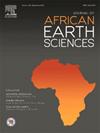Interpretation of 40Ar/39Ar geochronological data to infer mineralization events in Archean terranes: Comment on Bineli Betsi et al. (2025)
IF 2.2
4区 地球科学
Q2 GEOSCIENCES, MULTIDISCIPLINARY
引用次数: 0
Abstract
In spite of the wide use of 40Ar/39Ar geochronology of potassium-bearing minerals to date mineral deposits, caution needs to be exercised in the interpretation as there is a high chance that the ages have been modified by subsequent events not related to the mineralization. This comment addresses the contentious nature of the c.550 Ma 40Ar/39Ar hydrothermal K-feldspar ages from the Mowana copper deposit in NE Botswana, and used by Bineli Betsi et al. (2025) to invoke a much younger mineralization event not compatible with known geologic events within the host Archean terrane. Comparable U-Pb zircon lower intercept ages are widely reported from the different Archean terranes in the region, and shown to be a common result of sub-recent weathering-related Pb-loss. The highly disturbed nature of the 40Ar/39Ar spectra presented in Bineli Betsi et al. (2025) is a testament to the modification of the dated K-feldspar and the obtained ages are re-interpreted to indicate alkali redistribution related to weathering in the Archean hinterland. Instead, the Paleoproterozoic ages obtained by earlier studies from Pb-Pb sulphides are suggested to be closer to the timing of mineralization at the Mowana copper deposit.
利用40Ar/39Ar年代学资料推断太古宙地体成矿事件:评Bineli Betsi等(2025)
尽管广泛使用含钾矿物的40Ar/39Ar年代学来确定矿床的年代,但在解释时需要谨慎,因为与矿化无关的后续事件很有可能修改了年龄。这个评论针对的是c.550有争议的性质来自博茨瓦纳东北部Mowana铜矿的Ma 40Ar/39Ar热液钾长石年龄,Bineli Betsi等人(2025)利用该年龄推断出一个更年轻的成矿事件,该事件与太古宙地体中已知的地质事件不相容。在该地区不同太古宙地体中广泛报道了类似的U-Pb锆石下截距年龄,并表明这是亚近代气候相关的pb损失的共同结果。Bineli Betsi等人(2025)提出的40Ar/39Ar光谱的高度扰动性质证明了对年代k -长石的修改,并重新解释了所获得的年龄,以表明与太古宙腹地风化有关的碱再分配。相反,早期Pb-Pb硫化物研究得出的古元古代年龄更接近Mowana铜矿成矿时间。
本文章由计算机程序翻译,如有差异,请以英文原文为准。
求助全文
约1分钟内获得全文
求助全文
来源期刊

Journal of African Earth Sciences
地学-地球科学综合
CiteScore
4.70
自引率
4.30%
发文量
240
审稿时长
12 months
期刊介绍:
The Journal of African Earth Sciences sees itself as the prime geological journal for all aspects of the Earth Sciences about the African plate. Papers dealing with peripheral areas are welcome if they demonstrate a tight link with Africa.
The Journal publishes high quality, peer-reviewed scientific papers. It is devoted primarily to research papers but short communications relating to new developments of broad interest, reviews and book reviews will also be considered. Papers must have international appeal and should present work of more regional than local significance and dealing with well identified and justified scientific questions. Specialised technical papers, analytical or exploration reports must be avoided. Papers on applied geology should preferably be linked to such core disciplines and must be addressed to a more general geoscientific audience.
 求助内容:
求助内容: 应助结果提醒方式:
应助结果提醒方式:


